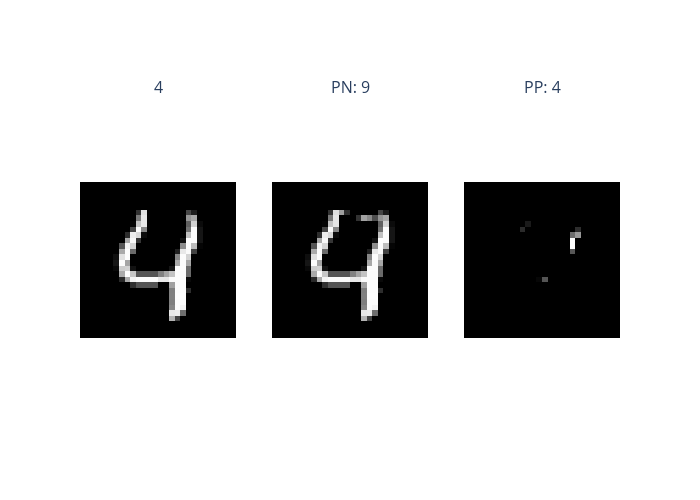Contrastive explanation on MNIST (Tensorflow)
This is an example of ContrastiveExplainer on MNIST with a Tensorflow model. ContrastiveExplainer is an optimization based method for generating explanations (pertinent negatives and pertinent positives), supporting classification tasks only. If using this explainer, please cite the original work: https://arxiv.org/abs/1802.07623.
[1]:
# This default renderer is used for sphinx docs only. Please delete this cell in IPython.
import plotly.io as pio
pio.renderers.default = "png"
[2]:
import numpy as np
import tensorflow as tf
import matplotlib.pyplot as plt
from omnixai.data.image import Image
from omnixai.explainers.vision import ContrastiveExplainer
The following code loads the training and test datasets. We recommend using Image to represent a batch of images. Image can be constructed from a numpy array or a Pillow image. In this example, Image is constructed from a numpy array containing a batch of digit images.
[3]:
# Load the MNIST dataset
img_rows, img_cols = 28, 28
(x_train, y_train), (x_test, y_test) = tf.keras.datasets.mnist.load_data()
if tf.keras.backend.image_data_format() == 'channels_first':
x_train = x_train.reshape(x_train.shape[0], 1, img_rows, img_cols)
x_test = x_test.reshape(x_test.shape[0], 1, img_rows, img_cols)
input_shape = (1, img_rows, img_cols)
else:
x_train = x_train.reshape(x_train.shape[0], img_rows, img_cols, 1)
x_test = x_test.reshape(x_test.shape[0], img_rows, img_cols, 1)
input_shape = (img_rows, img_cols, 1)
# Use `Image` objects to represent the training and test datasets
train_imgs, train_labels = Image(x_train.astype('float32'), batched=True), y_train
test_imgs, test_labels = Image(x_test.astype('float32'), batched=True), y_test
The preprocessing function takes an Image instance as its input and outputs the processed features that the ML model consumes. In this example, the pixel values are normalized to [0, 1].
[4]:
preprocess_func = lambda x: np.expand_dims(x.to_numpy() / 255, axis=-1)
We train a simple convolutional neural network for this task. The network has two convolutional layers and one dense hidden layer.
[5]:
batch_size = 128
num_classes = 10
epochs = 10
# Preprocess the training and test data
x_train = preprocess_func(train_imgs)
x_test = preprocess_func(test_imgs)
y_train = tf.keras.utils.to_categorical(y_train, num_classes)
y_test = tf.keras.utils.to_categorical(y_test, num_classes)
# Model structure
model = tf.keras.models.Sequential()
model.add(tf.keras.layers.Conv2D(
32, kernel_size=(3, 3), activation='relu', input_shape=input_shape))
model.add(tf.keras.layers.Conv2D(64, (3, 3), activation='relu'))
model.add(tf.keras.layers.MaxPooling2D(pool_size=(2, 2)))
model.add(tf.keras.layers.Dropout(0.1))
model.add(tf.keras.layers.Flatten())
model.add(tf.keras.layers.Dense(128, activation='relu'))
model.add(tf.keras.layers.Dropout(0.1))
model.add(tf.keras.layers.Dense(num_classes))
# Train the model
model.compile(
loss=tf.keras.losses.CategoricalCrossentropy(from_logits=True),
optimizer=tf.keras.optimizers.Adam(),
metrics=['accuracy']
)
model.fit(
x_train, y_train,
batch_size=batch_size,
epochs=epochs,
verbose=1,
validation_data=(x_test, y_test)
)
score = model.evaluate(x_test, y_test, verbose=0)
print('Test loss:', score[0])
print('Test accuracy:', score[1])
Epoch 1/10
469/469 [==============================] - 2s 5ms/step - loss: 0.1712 - accuracy: 0.9493 - val_loss: 0.0509 - val_accuracy: 0.9837
Epoch 2/10
469/469 [==============================] - 2s 5ms/step - loss: 0.0467 - accuracy: 0.9857 - val_loss: 0.0364 - val_accuracy: 0.9880
Epoch 3/10
469/469 [==============================] - 2s 5ms/step - loss: 0.0331 - accuracy: 0.9896 - val_loss: 0.0323 - val_accuracy: 0.9884
Epoch 4/10
469/469 [==============================] - 2s 5ms/step - loss: 0.0226 - accuracy: 0.9927 - val_loss: 0.0345 - val_accuracy: 0.9890
Epoch 5/10
469/469 [==============================] - 2s 5ms/step - loss: 0.0171 - accuracy: 0.9942 - val_loss: 0.0371 - val_accuracy: 0.9880
Epoch 6/10
469/469 [==============================] - 2s 5ms/step - loss: 0.0150 - accuracy: 0.9949 - val_loss: 0.0297 - val_accuracy: 0.9906
Epoch 7/10
469/469 [==============================] - 2s 5ms/step - loss: 0.0109 - accuracy: 0.9966 - val_loss: 0.0428 - val_accuracy: 0.9887
Epoch 8/10
469/469 [==============================] - 2s 5ms/step - loss: 0.0101 - accuracy: 0.9967 - val_loss: 0.0356 - val_accuracy: 0.9895
Epoch 9/10
469/469 [==============================] - 2s 5ms/step - loss: 0.0086 - accuracy: 0.9969 - val_loss: 0.0393 - val_accuracy: 0.9892
Epoch 10/10
469/469 [==============================] - 2s 5ms/step - loss: 0.0065 - accuracy: 0.9977 - val_loss: 0.0399 - val_accuracy: 0.9898
Test loss: 0.03988948091864586
Test accuracy: 0.989799976348877
To initialize ContrastiveExplainer, we need to set the following parameters:
model: The ML model to explain, e.g.,torch.nn.Moduleortf.keras.Model.preprocess_function: The preprocessing function that converts the raw data (aImageinstance) into the inputs ofmodel.“optimization parameters”: e.g.,
binary_search_steps,num_iterations. Please refer to the docs for more details.
[6]:
explainer = ContrastiveExplainer(
model=model,
preprocess_function=preprocess_func
)
We can simply call explainer.explain to generate explanations for this classification task. ipython_plot plots the generated explanations in IPython. Parameter index indicates which instance to plot, e.g., index = 0 means plotting the first instance in test_imgs[0:5].
[7]:
explanations = explainer.explain(test_imgs[0:5])
explanations.ipython_plot(index=4)
Binary step: 5 |----------------------------------------| 0.6%
